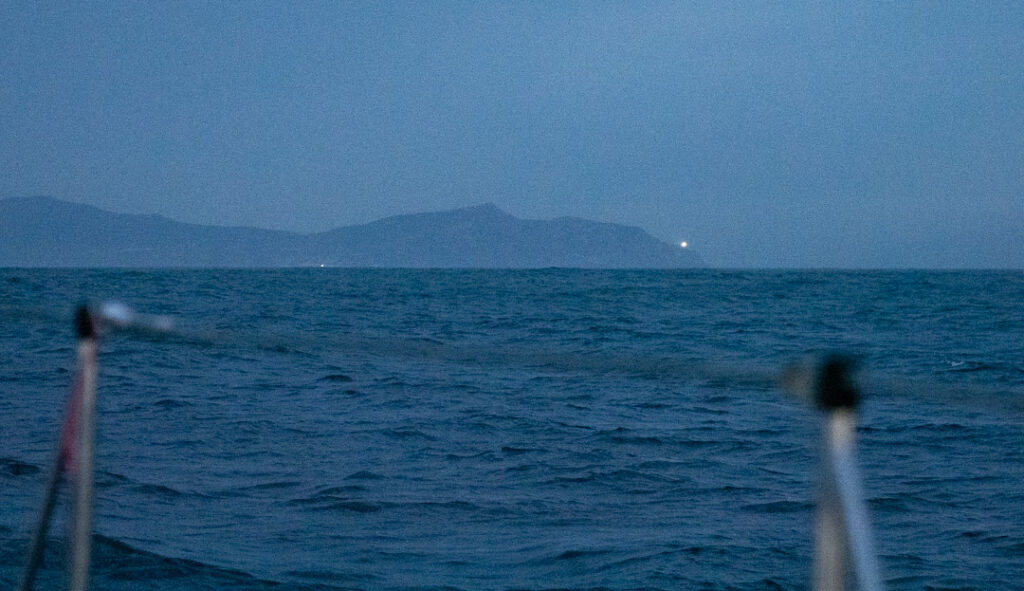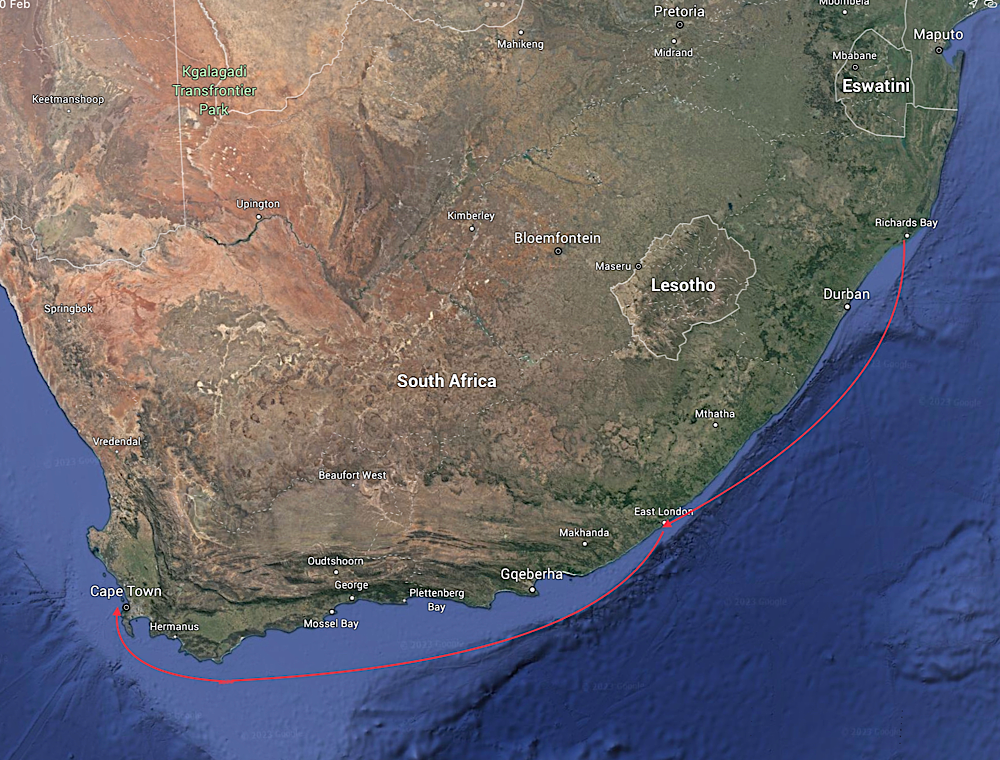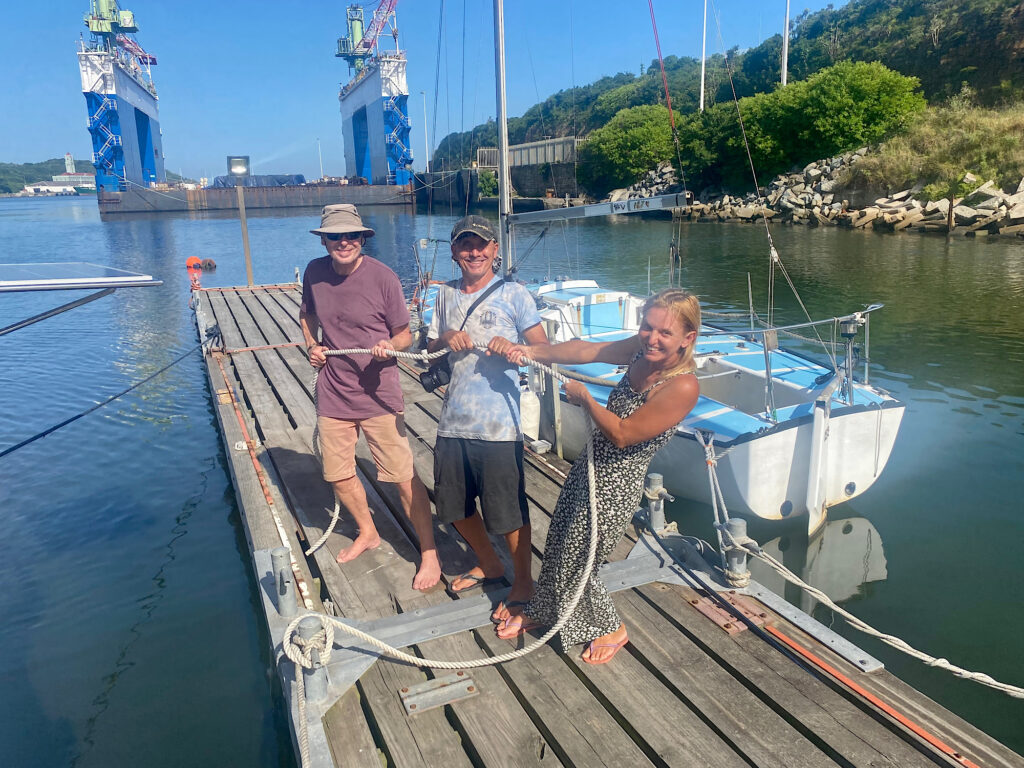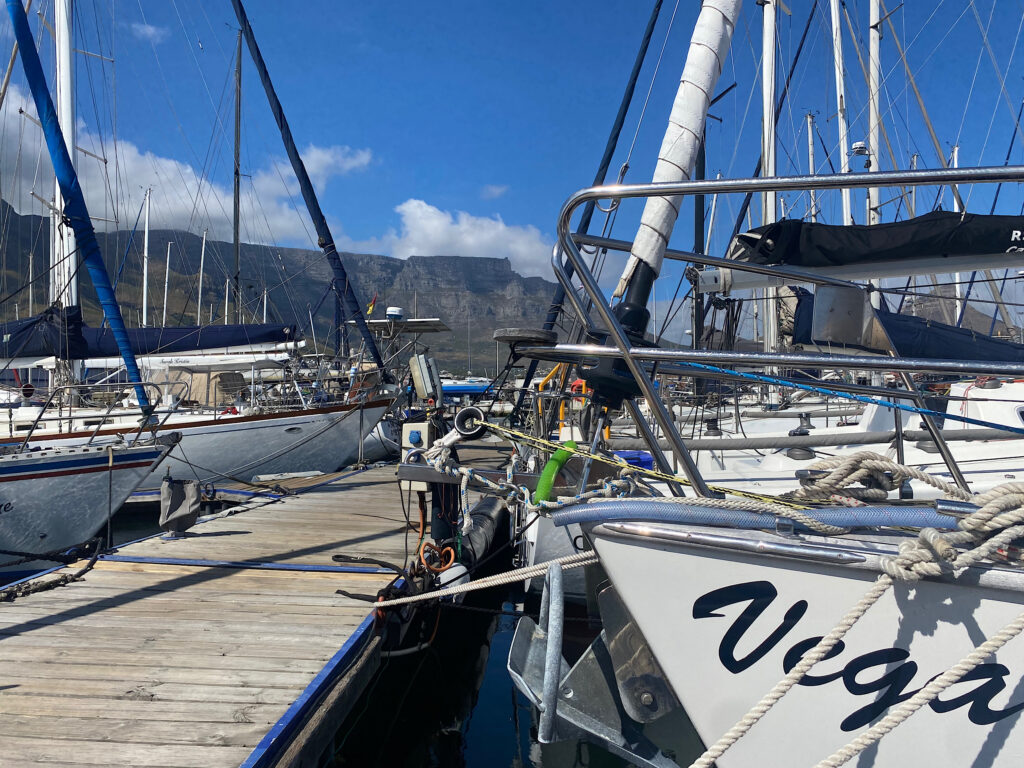Home in Bristol – 3rd to 28th December
We’d arrived back at Heathrow on December 3rd and it was cold. Hugh was in shorts and sandals so one of our first tasks when we got back to Bristol was to buy him sturdy boots and a new sailing jacket. The gloves and woolly hats came next as the weather hit -1 degrees and it snowed. When it wasn’t cold it was mostly overcast and raining. It was absolutely wonderful to see family, with visits to London, Cardiff and Devon, and to get together with friends, and especially for me to spend Christmas Day with my children, their partners and little grandson Charlie, but after four weeks home we were rather looking forward to returning to the heat and sunshine of South Africa.
Richards Bay – Thursday 29th December to Saturday 8th January
The day we arrived back at King Shaka airport, Durban it was raining. We collected our hire car, and our newly repaired genoa sail from Clinton, who kindly met us at the airport, and Hugh drove the 90 miles to Richard’s Bay along the unlit and poorly marked motorway in darkness and heavy rain.
By the time we got back many of our cruiser friends had left Richards Bay and were enjoying the delights of Cape Town with excursions up Table Mountain and to vineyards of the Western Cape. We heard enthusiastic reports of the city and felt rather jealous when a weather window appeared a few days after we were back and another five boats headed off south. We still had some work to be done on Vega before we left and so celebrated the New Year with friends Pepe & Blanka (SY Argo) from Czechia, and Martin & Susan (SY Shenemere) a South African/ American couple, as well as local Eric (the friendly taxi driver) and his girlfriend. The South Africans like to party and the Yacht Club was focus for many families camping out, with a braai (BBQ), copious amounts of alcohol, music and dancing, and fireworks going off all evening culminating in a massive display at midnight.
Whilst we’d been away Jacques and his team had been getting on with jobs on Vega and the day after our return he dropped by to say hello and to update us. We still had a non-functioning heads (ie loo) which had been giving us problems since leaving the Seychelles and, despite removing some large calcium deposits from the duck valve in the exit pipe and checking the pump unit, it was still not working. It was probably due to the outlet hoses blocked by calcium deposits so we bought 10 bottles of 5% vinegar and poured it down the hoses, which started fizzing away. Some days later one of Jacques guys took the hoses and valve assembly away and used concentrated hydrochloride acid to do the job properly, having found them to be completely blocked. A week later, when out at sea, we found evil-looking brown liquid leaking from the pump…. so we still can’t use our heads (back to the plastic bowl until we can fix it properly in Cape Town).
Below: the outlet hose blocked with calcium deposits & refitting the lever valve, which directs the effluent into our holding tank or out to sea, nice and shiny after soaking in HCl.
[easy-image-collage id=7452]It’s about 900 miles from Richard’s Bay to Cape Town and would be the third and last of the passages that I’d been dreading… firstly the sail from the Seychelles to Mayotte and the next one down the Mozambique Channel to Richards Bay, both of which had been much easier that we’d feared. With the strong Agulhas Current running north to south, it is vital to chose a weather window when the wind blows from north to south and not when strong winds sweep from the west around the bottom of South Africa and then to the north up the Mozambique Channel.
Very sadly Hugh’s father died on 5th January. He’d celebrated his 100th birthday in September with most of the family present and had been sent a birthday card from King Charles and Camilla. We’d seen him the week before when he was sleeping most of the time and looking increasingly frail, and he just passed away peacefully in his sleep. So Hugh will return to the U.K. for his funeral while I stay on Vega to supervise work that needs to be done. We had time, we hoped and expected, to get to Cape Town ourselves well before the funeral, and we had been watching for a possible weather window which should get us the 340 miles down the coast as far as East London.
Whilst we were waiting to head south I started provisioning for the trip back to the U.K. Food is relatively cheap in South Africa and we have some very long passages ahead of us to get home, which we hope to do by May or June. So I’m looking at provisioning at least to the Caribbean, over two months of food, and ideally beyond this with non-perishables but I’m not sure where we’ll store it all on the boat! Woolworths here has an excellent food department, on a par with M&S in the U.K. but not quite so fearsomely expensive. Add to that online deliveries to the yacht club from Checkers (the Aldi equivalent) and that’s a good part of our provisioning sorted.
Richards Bay to East London – ‘the Wild Coast’ – 8th to 10th January
At last a suitable weather window arrived after ten days back in South Africa and we got ready to leave in the afternoon, helped off the pontoon by Henry, a single handed American sailor. I rarely manoeuvre the boat on and off moorings as I’m just not that good at it but with little wind and current it seemed a good time to practice. Needless to say I got the turning angle wrong and scratched a long gash in the gelcoat. I was shaken and Hugh was not amused but soon calmed down and fortunately it will be easy to repair at our next stop.
As we motored out to sea between the cargo ships at anchor outside the port of Richard’s Bay, the wind came up and we were able to raise the mainsail and enjoyed a fabulous and prolonged red sunset. In the pitch black night it felt rather scary to be out at sea again and I was glad when the moon rose above the horizon and illuminated the waves in our wake.
This part of the coast is known as the wild coast, so named for the 250 miles of rugged, undeveloped coastline which extends from south of Durban to East London. If the wind turns to come up from the south, with the strong Agulhas current running from north to south at up to 5 knots, wind against tide can raise huge waves. After you have passed Durban there are no safe stops along the way and if you get caught out here by a change in wind direction, and with nowhere to take refuge, the best option is to head closer in to the coast where the current is weaker. We had been warned however that the biggest hazard on this passage was likely to be colliding with a humpback whale migrating towards Antarctica, and damaging boat or whale, or both. In the event we didn’t see any which was a bit disappointing but also a relief.
The weather forecast showed we should be able to make it to East London in around two days, a couple of days before the favourable winds backed to southerlies. As we got further out to sea we picked up the Agulhas current and our speed gradually increased overnight from 6 to 9 knots. We had a day of fast, rather rolly sailing in strong winds and moderate seas with white horses topping the waves. By the second night at sea, as the wind came up to over 30 knots (near gale conditions) with big following seas, we were doing over 12 knots at times, surfing down the waves coming up from behind us. We dropped all our sails and were still doing over 10 knots under ‘bare poles’, about 5 knots of this probably current. Our Hydrovane was doing a grand job steering the boat but occasionally the seas caught the boat, turning her sideways to the wind and waves, and we had to hand steer, turning the wheel hard to straighten her and get her pointing down the waves again.
At 6am the wind died and backed, exactly as forecast and we started to motor towards the port of East London. As we neared the land, shortly after noon, a dense sea mist reduced our visibility to about 50 metres. There was no other shipping on AIS but I put the radar on in case there were fishing boats, as Hugh caught up on his sleep down below.
As we motored past the lighthouse and breakwater at the entrance to East London the mist cleared, giving way to bright sunshine, and we passed the container port and industrial area, heading towards the Buffalo River Yacht Club on the south shore of the river beyond. Pepe and Blanka had arrived from Durban before us and helped us onto the pontoon and the engine was off by 1600 hours. We’d done 355 miles in 46 hours, averaging 7.7 knots… a record for Vega (thanks to the Agulhas current and, of course, skilful navigation and sailing).
Photos below of our arrival in East London thanks to Pepe.
[easy-image-collage id=7463]East London – 10th to 14th January
Buffalo River Yacht Club is another very welcoming place to stop. The Commodore Peter and wife Glenda live on their catamaran here, another couple who are planning to leave South Africa but unsure to where.
That evening we joined Pepe and Blanka for a braai to celebrate our arrivals along with locals Henne, Franco and Judy (who runs the yacht club and bar). Henne is married to a Russian woman from Siberia he met through an internet dating site. He recounted hilarious stories of drinking vodka naked in the snow in Siberia to prove his suitability to marry her and then produced a bottle of Samogen (Russian moonshine) to be drunk with lemon slices dipped in sugar and coffee granules. It wasn’t quite as disgusting as it sounds, though we only had sips not wanting to suffer too much the next morning.
[easy-image-collage id=7476]Pepe and Blanka headed off the next day for a shortish hop down the coast to Port Elizabeth. Their yacht Argo is only 30 foot and slower than Vega, so they wanted to get as far south as possible whilst the wind was favourable. We stayed on in East London and got on with chores around the boat. Two more cruising boats arrived a day later in advance of the strong SW winds forecast to arrive that evening … Henry on Ceres (bringing us some delicious mahe mahe that he’d caught on the way), and Jim and Steph on Right Choice.
On our last day in East London we caught an Uber to the Nahoon Estuary Nature Reserve. We hadn’t left the Yacht Club before then as we’d been warned it was unsafe to walk outside the gates. One member of the yacht club had recently been beaten up badly and robbed whilst in the Mall in the town of East London. Our Uber driver reassured us that it was generally much safer here than in Jo’burg or Cape Town, you could drive around in East London with your car windows open, and that security is equally bad for both blacks and whites in this country.
The town didn’t look particularly attractive with little of interest to tourists but we enjoyed the walk along the Dassie Trail in the Nahoon Estuary Nature Reserve, through forest then along a boardwalk where the views open up and you find yourself walking past mangroves to the beach. The nature reserve was lovely, straddling a pretty river estuary with expensive-looking houses on the hillside and cliffs above. It was good to get out to walk and we enjoyed having our picnic watching a kingfisher swoop down to pick up fish in the stream and tiny fish and hermit crabs in the pool below.
On the way back our Uber driver was a young black woman who had lost the job she loved as a civil engineer overseeing building construction, as the South African economy is in such a bad way, she told us.
We’d been watching the weather forecasts and all the boats heading south planned to leave the next morning, so we had to have another braai at the yacht club to celebrate our departures.
[easy-image-collage id=7482]Cape Town via the Cape of Storms – 14th to 18th January
We would have liked to have stopped at some of the pretty bays on the way to Cape Town but with Hugh needing to get back to the U.K. for his father’s funeral, his flight booked for 25th January and a good weather window to get the 560 miles to Cape Town in about four days without stopping, we had to push on.
It was an uneventful passage as we continued south, by the evening speeding up as we reached the Agulhas current, about 40 miles offshore. The route round the bottom of S Africa is a busy shipping lane for cargo ships and tankers which we kept a close eye out for and called up if they seemed to be in danger of coming too close.
The Agulhas current curls around the the land and runs to the west, but by the evening of the second day the current had turned to head south and seemed unwilling to let us go. We didn’t fancy a trip down to Antarctica so put the engine on and motored hard west for several hours to get out of its grip.
By mid morning of day 4 at sea we neared Cape Agulhas, the southernmost tip of Africa, where the the warm waters of the Indian Ocean meet the cold waters of the Atlantic Ocean. We were about 7 miles offshore so it was only just visible as a low-lying grey strip of land on the horizon. Almost as thrilling was briefly getting some mobile phone signal, though Hugh thought our later lunch of fried mushrooms, boiled eggs and baked beans was pretty exciting too.
As we’d sailed further south and west it had gradually been getting colder. For years now we’ve worn just shorts and T-shirts when sailing, even at night. By now I was in vest, warm top and fleece with leggings and sailing trousers. At night on watch we took a sleeping bag and blanket into the cockpit to keep warm and got out the duvet after many years of just a sheet on the bed.
[easy-image-collage id=7492]From Cape Agulhas we turned WNW towards the the Cape of Good Hope. The Cape was originally named the Cape of Storms in the 1480s by the Portuguese explorer Bartolomeu Dias, but was later renamed Good Hope to attract more people to travel the Cape Sea Route around the bottom of Africa. Sadly Dias’s choice of names was probably more appropriate as he drowned 12 years later when his ship sank in a storm just off the Cape. We were lucky with the weather (or good passage planning rather) and the waves and winds were starting to die as we approached it, and at 0500 hrs we had to slow right down as I wanted to see it in daylight. The lighthouse at the end was flashing regularly as the outline of the land gradually emerged from the blackness. I woke Hugh but he was unimpressed and went back to bed. As dawn came with a bright patch of sky amongst the dense clouds, north of us was the jagged ridge of the Table Mountain National Park.

From here it was just 40 miles north to Cape Town. The wind died as expected and then came round from the north and we motored increasingly hard into the wind, the boat crashing into big waves, whilst staying 3 miles off the coast to avoid fishing boats and the crayfish pots that are tethered nearer the shore.
Approaching Cape Town a dense sea mist obscured the land and only cleared as we approached the breakwater and harbour wall, cloud initially obscuring Table Mountain.
We had called the Royal Cape Yacht Club to let them know we were on our way and 3 guys met us at the visitors pontoon to take our lines. Just as we almost reached the pontoon a gust of wind caught the boat, blowing us further into the marina. With strong wind behind the boat and insufficient turning room we appeared to be heading for disaster. I was standing by with a fender to prevent us crashing into other boats but quick off the mark one of the marina guys raced over in his dinghy and managed to push our bow round so we could return and tie up. Undignified but no doubt they’ve seen it all before.
So… we were in Cape Town! Absolutely thrilled and relieved to have completed the passage here so painlessly!
It feels an enormous achievement to have made it all the way to Cape Town. We had heard so many stories about the dangerous passage through the Mozambique Channel and around the bottom of South Africa that we were both quite nervous about it. But we’re here and I feel incredibly proud of us both… and Vega too, of course!



8 Comments
Paul Bayley
February 11, 2023 - 10:56 amGosh another hairy time in parts but glad it was not as bad as you thought, Cape Town is beautiful and the scenery is stunning .
Paul
annie
February 11, 2023 - 1:35 pmThanks Paul
We have yet to see much of Cape Town, with Hugh’s trip to the U.K. and now Covid keeping us confined to the boat. We’ll be returning next year to properly explore!
Annie x
Gerard
February 11, 2023 - 11:12 amCondolences to Hugo on his father’s death but what a grand age
The most exciting stage turned out ok but what a speed under bare poles. Jil very jealous as she always wanted to go to S A after she had to cancel her ticket in 1967 as newly married we needed all the cash.
annie
February 11, 2023 - 1:38 pmThanks Gerard
It’s certainly a stunning location and we had hoped to explore more… not sure we’ll get the chance now thanks to Covid ☹️
Mike Peel
February 11, 2023 - 11:38 amWell done! I am not sure I would want to do the same. I have driven to Cape Town from Durban but not sailed. My sailing was inDurban in a 30 square meter. That meal sounded tasty. You need HP souse with the beans.
Hugh your Dad did well. 100 plus and a letter from the King!
Love. Mike
annie
February 11, 2023 - 1:42 pmHi Mike
yes I’m relieved to have done the trip.
We should be home by June so see you then, hopefully for a rather more tasty meal
Annie X
Jerry
February 11, 2023 - 4:57 pmDear Anne and Hugh
I’m so sorry to hear about Stewart, but wonderful that you were able to see him in December. He must have been one of the first centenarians to receive a telegram from the new King!
Enjoy the rest of the trip, and looking forward to your next blog,
Jerry xx
annie
April 28, 2023 - 4:12 pmHi Jerry. Thanks for your condolences. I’m not sure Stewart appreciated the telegram as he had dementia.. but the rest of the family enjoyed it xx